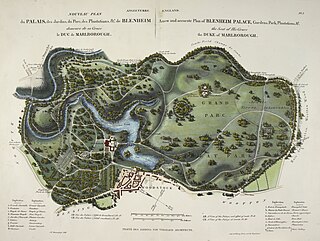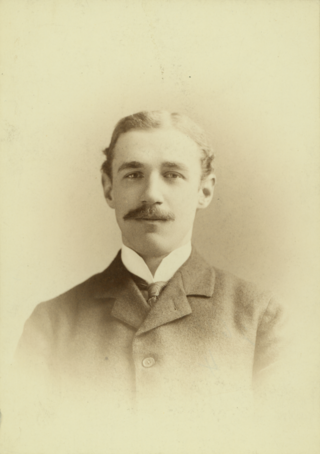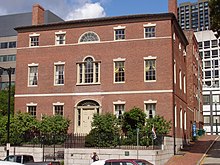
The National Trust for Historic Preservation is a privately funded, nonprofit organization based in Washington, D.C., that works in the field of historic preservation in the United States. The member-supported organization was founded in 1949 by congressional charter to support the preservation of America’s diverse historic buildings, neighborhoods, and heritage through its programs, resources, and advocacy.

The Isabella Stewart Gardner Museum is an art museum in Boston, Massachusetts, which houses significant examples of European, Asian, and American art. Its collection includes paintings, sculpture, tapestries, and decorative arts. It was founded by Isabella Stewart Gardner, whose will called for her art collection to be permanently exhibited "for the education and enjoyment of the public forever."

Historic preservation (US), built heritage preservation or built heritage conservation (UK) is an endeavor that seeks to preserve, conserve and protect buildings, objects, landscapes or other artifacts of historical significance. It is a philosophical concept that became popular in the twentieth century, which maintains that cities as products of centuries' development should be obligated to protect their patrimonial legacy. The term refers specifically to the preservation of the built environment, and not to preservation of, for example, primeval forests or wilderness.

Conservation and restoration of immovable cultural property describes the process through which the material, historical, and design integrity of any immovable cultural property are prolonged through carefully planned interventions. The individual engaged in this pursuit is known as an architectural conservator-restorer. Decisions of when and how to engage in an intervention are critical to the ultimate conservation-restoration of cultural heritage. Ultimately, the decision is value based: a combination of artistic, contextual, and informational values is normally considered. In some cases, a decision to not intervene may be the most appropriate choice.

The Longfellow House–Washington's Headquarters National Historic Site is a historic site located at 105 Brattle Street in Cambridge, Massachusetts. It was the home of noted American poet Henry Wadsworth Longfellow for almost 50 years, and it had previously served as the headquarters of General George Washington (1775–76).

The Trustees of Reservations is a non-profit land conservation and historic preservation organization dedicated to preserving natural and historical places in the Commonwealth of Massachusetts. It is the oldest land conservation nonprofit organization of its kind in the world and has 100,000 member households as of 2021. In addition to land stewardship, the organization is also active in conservation partnerships, community supported agriculture (CSA), environmental and conservation education, community preservation and development, and green building. The Trustees owns title to 120 properties on 27,000 acres (11,000 ha) in Massachusetts, all of which are open to the public. In addition, it holds 393 conservation restrictions to protect an additional 20,000 acres (8,100 ha). Properties include historic mansions, estates, and gardens; woodland preserves; waterfalls; mountain peaks; wetlands and riverways; coastal bluffs, beaches, and barrier islands; farmland and CSA projects; and archaeological sites.
Abbott Lowell Cummings was a noted architectural historian and genealogist, best known for his study of New England architecture.

Historic garden conservation is a specialised type of historic preservation and conservation or restoration concerned with historical and landmark gardens and designed landscapes.

William Sumner Appleton Jr. was founder of the Society for the Preservation of New England Antiquities (SPNEA) in 1910. He was the chief force behind much of the preservation of historic homes in the New England area.

Beauport, also known as Sleeper–McCann House, Little Beauport, or Henry Davis Sleeper House, is a historic house in Gloucester, Massachusetts, USA.

The Richard Jackson House is a historic house in Portsmouth, New Hampshire. Built in 1664 by Richard Jackson, it is the oldest wood-frame house in New Hampshire. It was designated a National Historic Landmark in 1968. It is now a historic house museum owned by Historic New England, and is open two Saturdays a month between June and October.
The Preservation Foundation of Palm Beach is a private, nonprofit membership organization dedicated to the preservation of the historic, architectural, as well as cultural heritage of Palm Beach, Florida. Through advocacy initiatives, educational programs, architectural resources, and cultural events, the foundation’s goal is to encourage the community to learn about and save the historic buildings that make the town of Palm Beach special.
Historic preservation in New York is activity undertaken to conserve forests, buildings, ships, sacred burial grounds, water purity and other objects of cultural importance in New York in ways that allow them to communicate meaningfully about past practices, events, and people.

The Harrison House, also known as Harrison–Linsley House and incorrectly as the Swain-Harrison House, is a historic house museum at 124 Main Street in Branford, Connecticut. Built in 1724 by a descendant of Branford's founders, it is a good example of a Connecticut saltbox structure. The house was listed on the National Register of Historic Places in 1975, and is a contributing property to the Canoe Brook Historic District. Since 2016 it has been operated as a house museum by the Branford Historical Society.
Joshua's Tract Conservation and Historic Trust, or Joshua's Trust, is a non-profit 501(c)(3) land trust operating in northeast Connecticut. Joshua's Trust was incorporated in 1966 to help conserve property of significant natural or historic interest. As of 2011, the Trust protects more than 5,000 acres, maintains 42 miles of trails that are open to the public, holds educational outreach programs, and publishes the Joshua's Tract Walkbook.
Protected areas of Ukraine are special areas of Ukraine established with the goal of protecting the natural and cultural heritage of the country from excessive changes as a result of human activity. The protection of the areas is the responsibility of the government of Ukraine, specifically the Cabinet of Ministers of Ukraine.
Morgan W. Phillips (1943–1996) was an American founder of the field of architectural conservation. He is credited with coining the term "architectural conservation" in the early 1970s and was among the first to call himself an architectural conservator. Phillips worked for most of his career at the Society for the Preservation of New England Antiquities (SPNEA) in Boston, now Historic New England, and the organization's Conservation Center was largely built around his research and that of his apprentices.

A photograph conservator is a professional who examines, documents, researches, and treats photographs, including documenting the structure and condition of art works through written and photographic records, monitoring conditions of works in storage and exhibition and transit environments. This person also performs all aspects of the treatment of photographs and related artworks with adherence to the professional Code of Ethics.

The Parson Smith House is a historic house on River Road in southern Windham, Maine. Built in 1764 and virtually unaltered since, it is one of the state's finest examples of Colonial Georgian architecture. It was listed on the National Register of Historic Places in 1973. Now a private residence, it was for 40 years a historic house museum owned and operated by the Society for the Preservation of New England Antiquities.

The exhibition of cultural property is a practice used by organizations where collected objects are put on display to the public. The objects are carefully chosen and placed together to offer educational value, and often to tell a story.
















